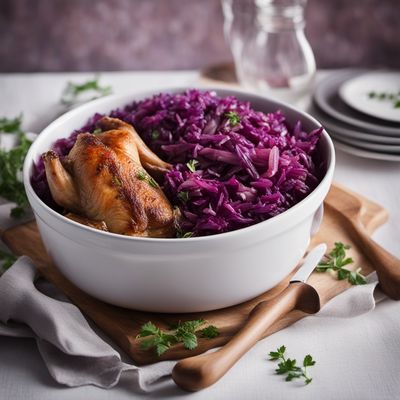
Ingredient
Red cabbages
The Vibrant Jewel: Red Cabbages
Red cabbages are characterized by their round shape, tightly packed leaves, and vibrant purple color. They have a firm and crunchy texture, making them ideal for salads and slaws. The flavor of red cabbage is slightly peppery and earthy, with a hint of sweetness. When cooked, the color intensifies, and the cabbage becomes tender and mellow in taste. Red cabbages are often used in pickling, braising, or roasting recipes, as well as in fermented dishes like sauerkraut.
Origins and history
Red cabbages have been cultivated for centuries and have their origins in the Mediterranean region. They were highly valued by the ancient Greeks and Romans for their medicinal properties and were believed to have healing effects on the digestive system. Over time, red cabbages spread throughout Europe and became a staple in many cuisines. Today, they are grown in various parts of the world, including Europe, North America, and Asia.
Nutritional information
Red cabbage is a nutritional powerhouse, packed with vitamins, minerals, and antioxidants. It is an excellent source of vitamin C, vitamin K, and dietary fiber. It also contains anthocyanins, which are responsible for its vibrant purple color and have been linked to numerous health benefits, including reducing inflammation and promoting heart health. Additionally, red cabbage is low in calories and carbohydrates, making it a healthy addition to any diet.
Allergens
There are no known allergens associated with red cabbage, but individuals with a known sensitivity to cruciferous vegetables, such as broccoli or cauliflower, may experience cross-reactivity and should consume red cabbage with caution.
How to select
When selecting red cabbages, choose heads that are firm and heavy for their size. The outer leaves should be crisp and tightly packed, with no signs of wilting or discoloration. Avoid cabbages with soft spots or browning leaves, as this may indicate age or spoilage. Additionally, look for vibrant purple color, as dull or faded color may indicate poor quality or age.
Storage recommendations
To keep red cabbage fresh, remove any loose or damaged outer leaves and store it in a plastic bag or airtight container in the refrigerator. Whole heads of red cabbage can be stored for up to two weeks, while sliced or shredded cabbage should be used within a few days. Avoid washing the cabbage until ready to use, as excess moisture can cause spoilage.
How to produce
Red cabbages can be grown in home gardens or purchased from grocery stores or farmers markets. They require well-drained soil, full sun, and regular watering. Start by planting seeds or seedlings in early spring or late summer, and the cabbage heads will be ready for harvest within a few months. Follow proper gardening practices, such as fertilizing and pest control, to ensure healthy growth.
Preparation tips
Red cabbage can be prepared in various ways, depending on personal preference and the desired dish. It can be thinly sliced and used raw in salads or slaws, providing a vibrant crunch and color. When cooked, red cabbage can be braised, roasted, or stir-fried to soften its texture and enhance its flavor. It is also commonly used in pickling recipes, such as sauerkraut or kimchi. To retain its vibrant color, add a splash of vinegar or lemon juice during cooking.
Culinary uses
Red cabbage is a versatile ingredient that can be used in a wide range of dishes. It is commonly used in salads, coleslaws, and pickled preparations. Red cabbage can also be added to stir-fries, soups, or stews to add color and texture. In some cuisines, it is used as a natural food coloring agent or as a wrap for fillings in dishes like cabbage rolls. Additionally, red cabbage can be fermented to make sauerkraut, a traditional German side dish.
Availability
Red cabbages are widely available in most grocery stores and supermarkets throughout the year. They are cultivated in many countries, including the United States, Germany, the Netherlands, and China.
More ingredients from this category
Recipes using Red cabbages » Browse all

Homemade Italian Sauerkraut
Zesty Fermented Cabbage Delight

Red Slaw Recipe
Tangy Beet and Cabbage Slaw

East Asian-inspired Pittsburgh Salad
Sesame-Ginger Pittsburgh Salad with Crispy Tofu

Spiced Red Cabbage Delight
Aromatic Hungarian Red Cabbage Medley

Roasted Goose with Red Cabbage and Potatoes
Danish Delight: Crispy Roasted Goose with Tangy Red Cabbage and Buttery Potatoes

German-style Braised Red Cabbage
Hearty Red Cabbage Delight

Dutch-style Braised Red Cabbage with Apples
Hearty Dutch Delight: Slow-cooked Red Cabbage with Sweet Apples

Roasted Duck with Red Cabbage and Potato Dumplings
Austrian Delight: Crispy Roasted Duck with Tangy Red Cabbage and Fluffy Potato Dumplings

Bacon-Wrapped Pork Meatballs with Noodle Salad
Savory Delight: Bacon-Wrapped Pork Meatballs with German Noodle Salad

Spiced Red Cabbage Stew
Savory Delight: Spiced Red Cabbage Stew from Eswatini

Smoked Lamb with Traditional Icelandic Flavors
Savor the Smoky Delights of Icelandic Hangikjöt

Homemade Danish Red Cabbage
Scandinavian Delight: Sweet and Tangy Homemade Danish Red Cabbage

